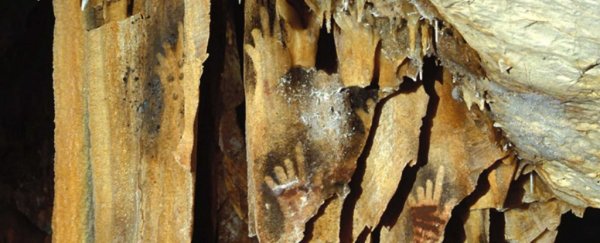In ancient cave art around the world, a particular motif shows up time and again: the impressions of the hands of the people who visited long ago, printed or stencilled.
And yet, in some caves decorated by the Palaeolithic inhabitants of France and Spain, something curious has been observed: A very high number of those hands seem to be missing fingers.
For many years, this peculiarity has been the subject of intense debate. How did they get that way? Since we humans rely heavily on our hands, it seems like it would be exceptionally careless for so many individuals to lose so many fingers accidentally.
That's why many archaeologists have concluded that the missing fingers are deliberate. But how, and why, has proven trickier to pin down. Some archaeologists argue that the artists merely folded their fingers down, or painted over parts of the stencil.
Others argue that the people who inhabited those regions engaged in a grisly practice: amputating their own fingers.
Sounds insane at first, but let's hear this out - a new study has just added its voice to the amputation side of the debate.
"Finger amputation was a reasonably common behaviour in many regions in the recent past," archaeologist Mark Collard of Simon Fraser University in Canada told New Scientist.
"The available data seem to fit reasonably well with the hypothesis that some Upper Palaeolithic people engaged in finger amputation for the purposes of religious sacrifice."
There are several lines of evidence the research team draws on to make its conclusion. The first is sheer numbers, recorded at a handful of sites (isolated examples can be found at other locations).
At Grotte de Gargas in Hautes-Pyrénées in France, 231 hand stencils have been recorded, made by around 45-50 individuals. Of these, 114 are missing one or more digits.
At Cosquer Cave, also in France, 28 of 49 hands are missing digits. And at Maltravieso in western Spain, 61 of 71 hand images are missing digits.
There's also evidence to suggest that there were people with missing fingers making the art. At Grotte de Gargas, archaeologist C. Barrière reported in 1976, there are impressions of human limbs found in hardened mud - some of which are distinctly missing digits. These impressions are thought to be the same age as the hand stencils.
It's possible - and in fact very likely - that some people in the Upper Palaeolithic lost fingers or parts of fingers accidentally, either to frostbite, or other forms of trauma. But many of the hand stencils seem to be missing multiple fingers - two, three, or even four in some cases.
And this is where the team draws a different line. They searched the Human Relation Area Files - a database of global human ethnographies - and found 121 recent societies around the world, in Africa, Eurasia, Oceania, and the Americas, that practice ritual finger amputation, demonstrating that it's a real, widespread practice even today (although it's in the process of dying out).
"I was pretty shocked," Collard said. "It seems like such a debilitating practice that I couldn't imagine signing up to do it myself. I still can't. Yet, we kept finding group after group that did it."
Reasons for doing so varied. It was practiced as an expression of extreme grief over the loss of a loved one in some cultures. Others used it for identification, like the fisherwomen of some Aboriginal Australian groups. It could also be used to mark marriage, or as a form of punishment.
Or it's practiced as a form of ritual sacrifice - which the researchers believe is probably the most likely explanation for why people of the Upper Palaeolithic could have been chopping off their own fingers, offering them up to a deity or supernatural power.
This could tell us something about the group dynamics, since traumatic religious rituals have been shown to strengthen interpersonal bonds.
But not everyone is convinced.
"None of the ethnographic cases they cite match the distinctive pattern seen in the ice age hand stencils - namely, a sequential shortening of fifth, fourth and third fingers, with the thumb spared," archaeologist Ian Gilligan of the University of Sydney, cited in the paper, but not associated with the research, told New Scientist.
"On the other hand, pun intended, this pattern matches precisely the effects of frostbite. The pattern corresponds to the differing susceptibility of fingers to frostbite, with the thumb not affected."
And archaeologists at Durham University believe that deliberate mutilation of this nature would be tantamount to suicide - so the gain in interpersonal relationships would not be worth the cost. They suggest that the fingers were bent or painted over as a form of symbolic communication.
And Dale Guthrie of the University of Chicago reckons it was kids mucking about.
But nor does the research team claim that amputation is definitely what occurred - the paper is the exploration of a possibility, not a definitive answer. In fact, it's possible that we may never get a definitive answer.
"While the case for favouring the amputation hypothesis is not airtight," the researchers wrote, "we are of the opinion that it is strong enough to warrant treating the hypothesis as if it is correct for the purposes of further investigation, and this is what we did in the study reported here."
The research has been published in the Journal of Paleolithic Archaeology.
